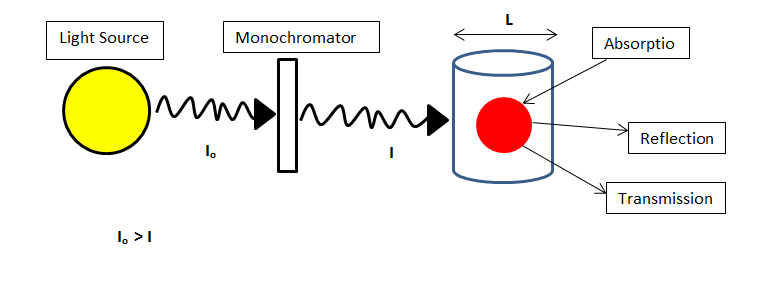Three things are possible when any light rays strikes on a surface
- Absorption
- Transmission
- Emission
Absorption means that the substance is absorbing only a particular wavelength of light ray it doesn’t mean that it will accept all the light falling on it.
Transmission means that when light is striking on the surface it does not react and light is passed as it was. There is no absorption or change in the wavelength of light.
Emission means that when light falls on a surface it absorbs the light and changes its wavelength and emit.
Beer lambert law only talks about the absorption of light by a substance.
 Here
we can see that when light is released from a light source and passed through a
monochromator the light coming from monochromator is not the same as it was
released from the light source it means that it means that light from the
monochromator is a kind of particular wavelength and intensity and when this
light is passed through the given substance the intensity of light decreases so
we can say that there is change in intensity of light. The difference in the
intensity of light before and after is absorbed by the substance or we can say
that absorption leads to decrease in transmission but the actual fact is that absorption is inversely proportional to the
transmission on the logarithmic scale.
Here
we can see that when light is released from a light source and passed through a
monochromator the light coming from monochromator is not the same as it was
released from the light source it means that it means that light from the
monochromator is a kind of particular wavelength and intensity and when this
light is passed through the given substance the intensity of light decreases so
we can say that there is change in intensity of light. The difference in the
intensity of light before and after is absorbed by the substance or we can say
that absorption leads to decrease in transmission but the actual fact is that absorption is inversely proportional to the
transmission on the logarithmic scale.


In beer lambert law we have combined the individual law given by both scientist Beer and Lambert.
1. Beer Law
Absorption is directly proportional to the concentration of the sample
A α C
2. Lambert Law
Absorption is directly proportional to the width of the sample.
A α L
Let’s combine these both equations
A α CL
As we know that when we remove this proportional sign we have to put a constant.
A = εCL
ε = Molar absorption coefficient
Lambert – Beer law
The absorbance of a solution is directly proportional to the concentration of the absorbing material present in the solution and path length.